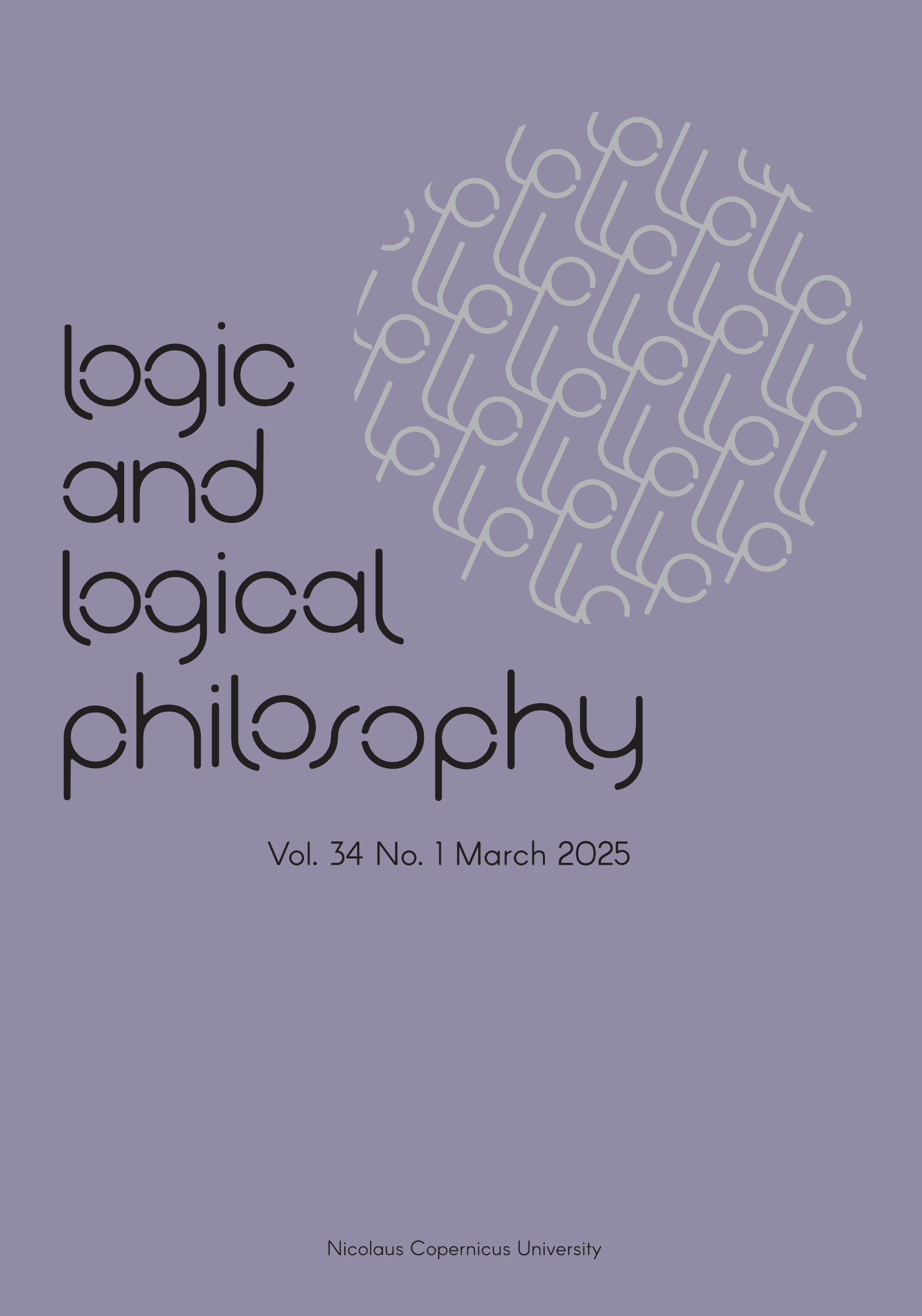Simplified Semantics for Further Relevant Logics I
Unreduced Semantics for E and Π′
DOI:
https://doi.org/10.12775/LLP.2024.021Keywords
converse conditional, E, fusion, γ, relevant logics, simplified Routley-Meyer semantics, unreduced framesAbstract
This paper shows that the relevant logics E and Π′ are strongly sound and complete with regards to a version of the “simplified” Routley-Meyer semantics. Such a semantics for E has been thought impossible. Although it is impossible if an admissible rule of E the rule of restricted assertion or equivalently Ackermann’s δ-rule is solely added as a primitive rule, it is very much possible when E is axiomatized in the way Anderson and Belnap did.
The simplified semantics for E and Π′ requires unreduced frames. Contra what has been claimed, however, no additional frame component is required over and above what’s required to model other relevant logics such as T and R. It is also shown how to modify the tonicity requirements of the ternary relation so as to allow for the standard truth condition for both fusion – the intensional conjunction ◦ – as well as the converse conditional ←.
References
Ackermann, W., 1956, “Begründung einer strengen Implikation”, Journal of Symbolic Logic, 21(2): 113–128. DOI: http://dx.doi.org/10.2307/2268750
Anderson, A. R., and N. D. Belnap, 1958, “A modification of Ackermann’s “rigorous implication””, Journal of Symbolic Logic, 23(4): 457–458. DOI: http://dx.doi.org/10.2307/2964046
Anderson, A. R., and N. D. Belnap, 1959, “Modalities in Ackermann’s “rigorous implication””, Journal of Symbolic Logic, 24(2): 107–111. DOI: http://dx.doi.org/10.2307/2964754
Anderson, A. R., and N. D. Belnap, 1975, Entailment: The Logic of Relevance and Necessity, volume 1, Princeton University Press, Princeton.
Anderson, A. R., N. D. Belnap, and M. J. Dunn, 1992, Entailment: The Logic of Relevance and Necessity, volume 2, Princeton University Press, Princeton. DOI: http://dx.doi.org/10.1515/9781400887071
Belnap, N. D., 1959, “A formalization of entailment”, PhD thesis, Yale University.
Belnap, N. D., 1960, “A formal analysis of entailment”, Technical Report No. 7, Contact No. SAR/Nonr-609(16), Office of Naval Research, New Haven.
Brady, R. T., 1984, “Natural deduction systems for some quantified relevant logics”, Logique et Analyse, 27(108): 355–377. http://www.jstor.org/stable/44084099
Brady, R. T., 2006, Universal Logic, CSLI Publication, Stanford.
Dunn, J. M., 1966, “The algebra of intensional logics”, PhD thesis, University of Pittsburgh. https://www.proquest.com/dissertations-theses/algebra-intensional-logics/docview/302201330/se-2
Galatos, N., P.Jipsen, T. Kowalski, and H. Ono, 2007, Residuated Lattices: An Algebraic Glimpse at Substructural Logics, Elsevier. DOI: http://dx.doi.org/10.1016/S0049-237X(07)80005-X
Kron, A., “Deduction theorems for relevant logics”, 1973, Mathematical Logic Quarterly, 19(3-6): 85–92. DOI: http://dx.doi.org/10.1002/malq.19730190306
Maksimowa, M., 1973, “A semantics for the calculus E of entailment”, Bulletin of the Section of Logic, 2(1): 18–20.
Mares, E. D., 2000, “CE is not a conservative extension of E”, Journal of Philosophical Logic, 29(3): 263–275. DOI: http://dx.doi.org/10.1023/A:1004731401855
Mares, E., 2024a, The Logic of Entailment and its History, Cambridge University Press. DOI: http://dx.doi.org/10.1017/9781009375283
Mares, E., 2024b, “Relevance logic”, in E. N. Zalta (ed.), The Stanford Encyclopedia of Philosophy, Metaphysics Research Lab, Stanford University, Summer 2024 edition. https://plato.stanford.edu/archives/sum2024/entries/logic-relevance/
Mares, E., and Sh. Standefer, 2017, “The relevant logic E and some close neighbours: A reinterpretation”, IfCoLog Journal of Logics and Their Applications, 4(3): 695–730. https://www.collegepublications.co.uk/downloads/ifcolog00012.pdf#page=155
Méndez, J. M., 2009, “A Routley-Meyer semantics for Ackermann’s logics of “strenge implication”,´’, Logic and Logical Philosophy, 18(3–4): 191–219. DOI: http://dx.doi.org/10.12775/LLP.2009.010
Méndez, J. M., G. Robles, and F. Salto, 2011, “Ticket Entailment plus the mingle axiom has the variable-sharing property”, Logic Journal of the IGPL, 20(1): 355–364. DOI: http://dx.doi.org/10.1093/jigpal/jzr046
Meyer, R. K., 1970, “E and S4”, Notre Dame J. Formal Logic, 11(2): 181–199. DOI: http://dx.doi.org/10.1305/ndjfl/1093893935
Meyer, R. K., and J. M. Dunn, 1969, “E, R and γ”, Journal of Symbolic Logic, 34: 460–474. DOI: http://dx.doi.org/10.2307/2270909
Ono, H., 2003, “Substructural logics and residuated lattices – an introduction”, pages 193–228 in V. F. Hendricks and J. Malinowski (eds.), Trends in Logic: 50 Years of Studia Logica, Springer Netherlands, Dordrecht. DOI: http://dx.doi.org/10.1007/978-94-017-3598-8_8
Øgaard, T. F., 2017, “Skolem functions in non-classical logics”, Australasian Journal of Logic, 14(1): 181–225. DOI: http://dx.doi.org/10.26686/ajl.v14i1.4031
Øgaard, T. F., 2021a, “Non-Boolean classical relevant logics I”, Synthese, 198: 6993–7024. DOI: http://dx.doi.org/10.1007/s11229-019-02507-z
Øgaard, T. F., 2021b, Non-Boolean classical relevant logics II: Classicality through truth-constants”, Synthese, 199: 6169–6201. DOI: http://dx.doi.org/10.1007/s11229-021-03065-z
Øgaard, T. F., 2024, “Simplified semantics for further relevant logics II: Propositional Constants”, Logic and Logical Philosophy. DOI: http://dx.doi.org/10.12775/LLP.2024.022
Priest, G., 2008, An Introduction to Non-Classical Logic. From If to Is, Cambridge University Press, Cambridge, 2nd edition. DOI: http://dx.doi.org/10.1017/CBO9780511801174
Priest, G., 2015, “Fusion and confusion”, Topoi, 34(1): 55–61. DOI: http://dx.doi.org/10.1007/s11245-013-9175-x
Priest, G., and R. Sylvan, 1992, “Simplified semantics for basic relevant logic”, Journal of Philosophical Logic, 21(2): 217–232. DOI: http://dx.doi.org/10.1007/BF00248640
Restall, G., “Simplified semantics for relevant logics (and some of their rivals)”, 1993, Journal of Philosophical Logic, 22(5): http://dx.doi.org/481–511. DOI: 10.1007/BF01349561
Restall, G., 2000, An Introduction to Substructural Logics, Routledge, London. DOI: http://dx.doi.org/10.4324/9780203016244
Restall, G., and T. Roy, 2009, “On permutation in simplified semantics”, Journal of Philosophical Logic, 38: 333–341. DOI: http://dx.doi.org/10.1007/s10992-009-9104-z
Robles, G., 2022, “The logic E-mingle and its Routley-Meyer semantics”, Bulletin of Symbolic Logic, 28(4): 599–600. DOI: http://dx.doi.org/10.2307/27187036
Routley, R., R. K. Meyer, V. Plumwood, and R. T. Brady, 1982, Relevant Logics and Their Rivals, volume 1, Ridgeview Publishing Company, Atascadero, California.
Slaney, J. K., 1984, “A metacompleteness theorem for contraction-free relevant logics”, Studia Logica, 43(1): 159–168. DOI: http://dx.doi.org/10.1007/BF00935747
Slaney, J., 1995, “MaGIC, matrix generator for implication connectives: Release 2.1 notes and guide”, Technical Report TR-ARP-11/95, Automated Reasoning Project, Australian National University. http://users.cecs.anu.edu.au/~jks/magic.html
Downloads
Published
How to Cite
Issue
Section
License
Copyright (c) 2024 Tore Fjetland Øgaard

This work is licensed under a Creative Commons Attribution-NoDerivatives 4.0 International License.
Stats
Number of views and downloads: 882
Number of citations: 0







